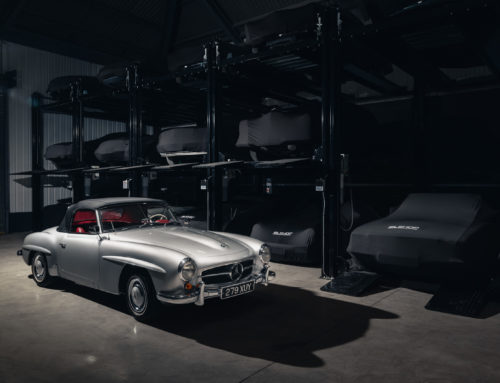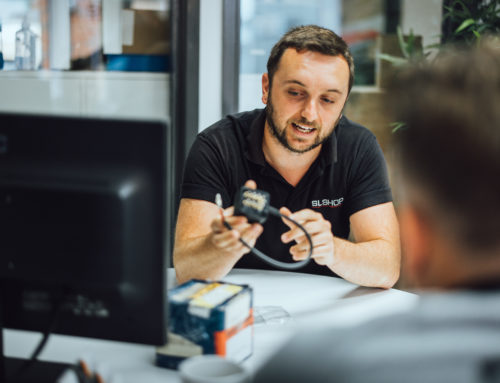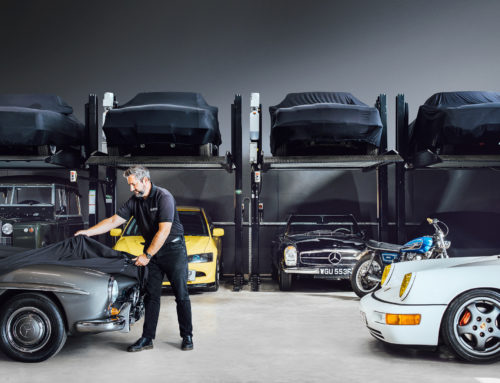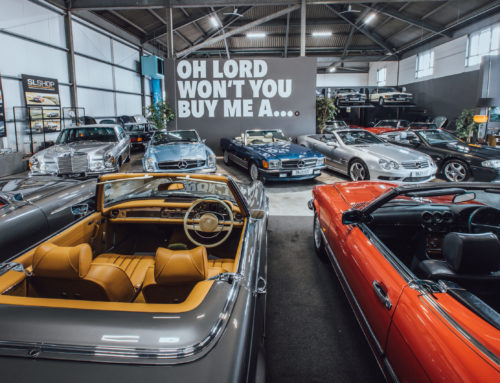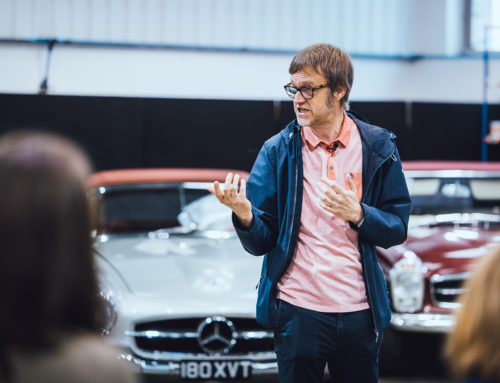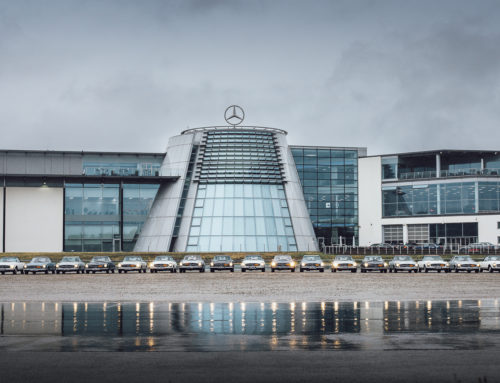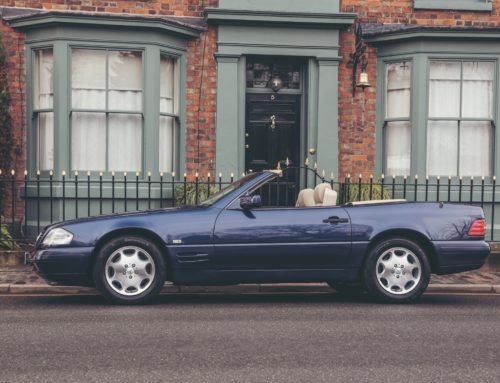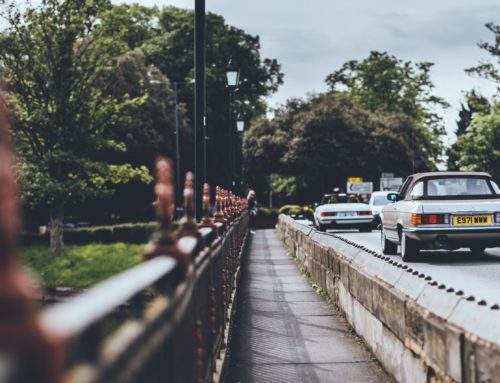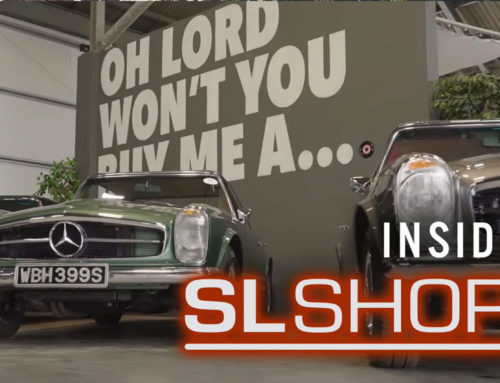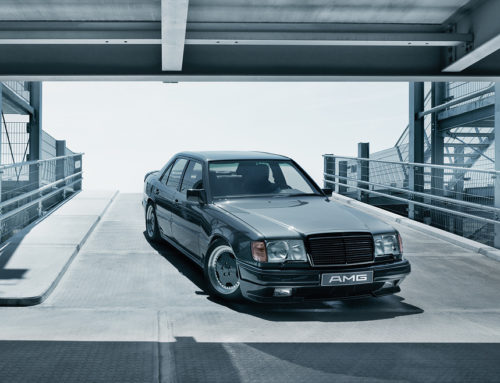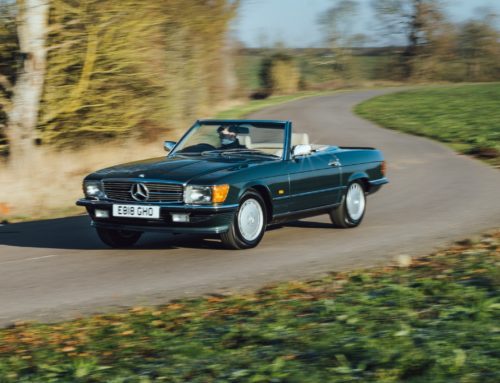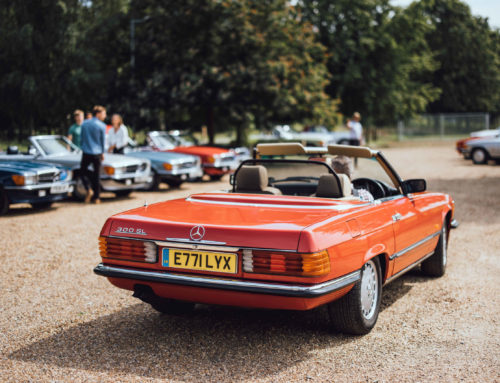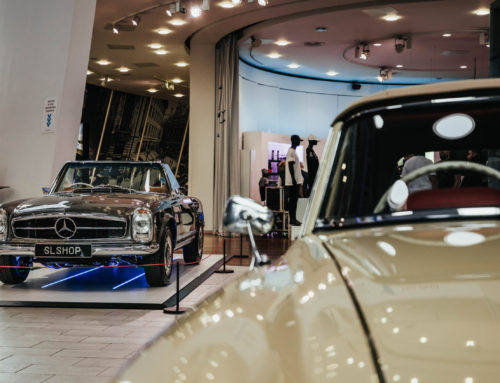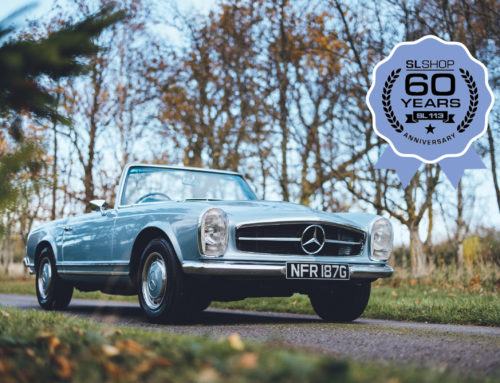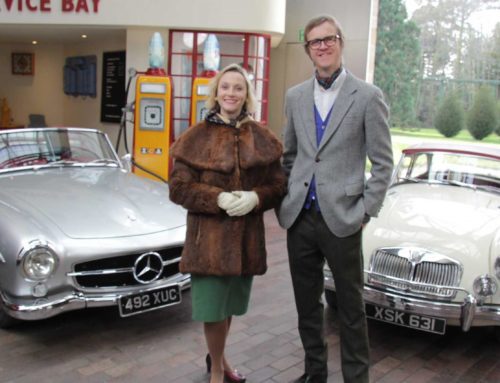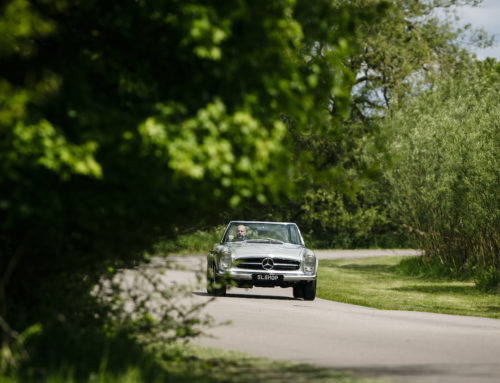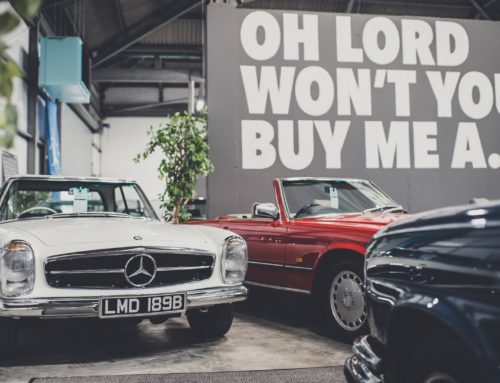Octane Magazine Mercedes 2022 Issue 224
The Mercedes-Benz R107 is the longest-lived and most numerous of all the SLS roadsters.
Here’s the full story behind its 50-year success.
Words: Massimo Delbo
Photography: Marco Nagel/Mercedes-Benz
At the age of 16 I fell in love. There, sharing the pages of a car magazine with a Ferrari 308 and a Jaguar XJ, was the Mercedes-Benz R107 SL. I dreamed of one for 14 years, before – finally! – buying a 500 SL to celebrate my 30th birthday. Today, 21 years and 100,000km later, she is still with me. And now, here we are, celebrating the R107’s 50th anniversary.
It will be quite hard for me to remain neutral as I describe the R107’s story. But what you can’t argue with is that this is the longest-lived Mercedes passenger car ever, in production for a healthy 18 years (only the military-based G-wagen was built for longer), from 1971 to 1989. It’s also the most prolific generation of the SL, selling a total of 237,287 examples during this time, increasing to 300,175 if you include the long-wheelbase SLC coupé.
It was a hit from day one, revolutionising the way a sporting convertible two-seater was perceived and making it very easy to use on a daily basis. And, even though the R107 might still seem relatively modern despite the five decades since its launch, let’s bear in mind what most people of the period were driving. In 1971 the best-selling car in Britain was the Austin-Morris 1100/1300; Germans liked the Volkswagen Beetle; Peugeot dominated in France with the 204; while in Italy the two-cylinder Fiat 500 led the market. As for sports cars, we had the outgoing Mercedes-Benz 280 SL ‘Pagoda’, the Porsche 911 in 2.4-litre form, and Ferrari with the Dino 246 – and while the Mercedes was available as a convertible with removable hardtop, the two latter came as coupés or with a targa top.
Variety is the Spice of Life
That same year, Jaguar launched the E-type Series 3 with the 12-cylinder engine, though it sold slowly. And in the USA, already a world apart in terms of cars, winning the sales race was the Chrysler New Yorker sedan, fully 5.7m long, 2.1 wide, equipped with a 7.2-litre V8 of just 220hp, burdened with a drag factor of 0.55 and a kerbweight over two tonnes. As for sports cars, most popular Stateside was the Corvette C3, with its glassfibre body and a broad selection of V8s.
Variety was clearly spicing up car lovers’ lives – yet the automotive world was in fibrillation. Several crises were exploding at once, as the price of oil sky-rocketed, forcing car manufacturers to revie their priorities when designing new cars, scaling down power and cubic capacity. Meanwhile, the USA began imposing ever-more stringent pollution limits and its new crash test programmes threatened the survival of sportier models – particularly those with a convertible roof.
R107 350 SL Launch
Yet despite these headwinds on 14 April 1971 Mercedes-Benz invited journalists from around the world to the Hockenheim racetrack, for the press launch of its new R107 350 SL. Here was the brand new model that would replace the legendary Pagoda, equipped with a 3.5-litre V8 and capable of a maximum speed of 212km/h (132mph).
‘We weren’t crazy,’ says engineer Frank Knothe, a 107 owner with a 1985 300 SL (red with black fabric; actually a very early press car) in his garage since 1989, and a 40-year career in Mercedes-Benz passenger car development. He started working on the 2.5-liture M130 engine of the Pagoda in 1967, and was part of the R107 development team from day one.
Typical German Engineering
‘We had to take the risk as the only other option would have been standing still,’ says Knothe. ‘With new safety legislation, the W113 Pagoda would have been impossible to sell in the USA, an inconceivable loss for us as the USA was the most important market for it. As for the engine, to scale up to a V8 was the only possible way to cope with the extra weight required to prepare the car for the new safety rules. The biggest limit to the project, and the most difficult, was that we didn’t know the exact rules the US would apply until very late in development, so we had to play safe.’
And safe they did indeed play it, in the most stereotypical German engineering fashion, with the final results exceeding every imposed rule, and creating the basis for the nickname that was assigned to the 107 series:Panzerwagen (‘armoured car’). The new SL was structurally as safe as a contemporary Mercedes sedan, thanks to its thickened steel monocoque, boxed sills and a purposely designed reinforced transmission tunnel. It’s a-pillars were made 50% stronger than the Pagoda’s, the fuel tank moved above the rear axle, and crumple zones were created front and rear to protect its very rigid cockpit.
Mercedes technicians discussed keeping the Pagoda’s six-cylinder engine, tuning it to get more power, but they already knew that, with the pollution limits soon to be imposed, a relaxed, bigger capacity V8 would perform far better than a squeezed straight-six.
The Perfect Engine
‘In every aspect of engineering, with the 107 we have been very lucky,’ says Knothe. ‘We knew that an unstressed V8 engine would perform better in terms of emissions, and from 1969 we had the perfect engine powering our W108 sedan. Yet we never thought of anything more. If, in the following years, we hadn’t found space for the catalyst in the car’s floor, we would have been forced to end production. And the fact that we found it was not engineering foresight but a stroke of luck.
As for the rest, the innate quality and appeal of the car meant it always sold so well, mostly in the USA, and the Mercedes bosses were happy to let it run for some years longer than originally expected. I’m not a marketing guy, but I’m sure that the constant presence of the R107 in successful movie and television series helped to keep its image fresh, too.’ Remember ‘Hart to Hart’? And ‘Dallas’? It wasn’t nicknamed the Bobby Ewing SL for nothing.
Work started on the new SL in 1965, and early sketches show a series of projects that resemble the Pagoda. The aim of chief designer Friedrich Geiger was to maintain traditional elegance yet link the new SL with the future S-Class. He feared a ban on convertible cars in the USA, so many sketches have indicated a targa-top variant – this same legislative threat led Jaguar to launch the XJ-S as the E-type’s replacement. Alongside Geiger, other big names included Rudolf Uhlenhaut, father of the 1950’s Silver Arrows, as chief engineer of Mercedes-Benz’s passenger car division, and Karl Wilfert, in charge of body development.
Speedbumps
The car was almost ready at the end of 1969, but the late board member and technical boss Hans Scherenberg pulled the brake. ‘The main concerns, again and again, were the American rules,’ he later remembered. ‘We knew an open version would have had more market appeal, but had to play it safe we should have had a steel roof, maybe with a wide sunroof.’ This internal debate went on to generate the C107 SLC series (approved in late 1969) – but, thankfully, it did not stop the convertible. ‘At the end, even though the decision to go with the open car was not an easy one, we gave it the green light.’
Predictably, the tally of developments that kept the R107 up to date during its 18-year career is bewildering. The body, mechanicals and interiors were often upgraded at different times, with the styling inside and out remaining almost identical bar small details throughout. Bodywork revisions arrived in 1980 and 1985, and though the interior was upgraded every year, the most significant changes arrived in 1973, 1977, 1980, 1982 and 1985.
As for the engines and transmissions, the story is quite complex, as the R107 received a grand total of eight different-capacity engines, mainly V8s (from 3.5 to 5.6 litres) but for two straight-sixes (2.8 and 3.0 litres). Why so many variants? They had to keep up with more and more stringent emission requirements, which also meant the early adoption of fuel injection and catalytic converters. Paired with these engines was a series of automatic transmissions (with three or four rations), whilst four-speed (initially) and five-speed (in the 1980s) manual gearboxes were made available for the very early 350 V8 and, later, the straight-six.
Automatic Wins
‘Nobody really wanted the manual,’ says Knothe. ‘So few were sold that it would have been a nonsense to keep this option available: Mercedes customers were more comfort-orientated, and our automatic was quite advanced too, minimalizing the gap in performance compared with a manual transmission. The decision to go automatic-only on the V8 was taken very early, and never questioned again. I remember, a few days before the launch at Hockenheim, we discussed whether we should be bringing manual cars, too. If we did, nobody noticed. It just wasn’t the right combination.’
Bearing in mind all the different iterations available, one of the most debated questions in R107 world is” which combination is best?
‘It really depends on your target,’ says Knothe. ‘The 107 is not a racer, but it is a perfect cruiser, for travelling in comfort and for enjoying some sporting attitude. On a very twisty road, he six-cylinder is better, as it is easier to drive in corners and on a faster road. But where you need torque, the V8 is the choice. A benefit of the V8, in European specification, is that they come with the anti-squat and anti-dive suspension system, really helping the balance of the car.’
He continues: “For me, the perfect 107 would have been a 5.0-litre V8 as light as the 3.0-litre six-cylinder unit – dynamically, I really would have loved to have these weighing 80 kilos less in the front! Still better if it could be paired with the front axle of the post-1985 car, which allows improved braking because it keeps the front wheels straighter. The same was true of the R129 generation that followed, where the V8 was better than the more powerful V12, just because of that extra weight in the front.’
The Perfect Drive
It’s time to take to the road. We’re in the 300 SL and, around the corners, I immediately perceive that relative lightness over the front wheels in comparison to my own 500 SL. It is much more alert in its steering, keener to change direction and with more positive feedback. Unusually, this one has a manual gearbox and is enjoyable to drive, its engine pulling well between 1500 and 4000rpm. Maximum power of 188bhp is released at 5700rpm, and the redline is 6200rpm, but maximum torque of 192lb ft is reached at 4400rpm, and the engine has given its all by then. As with its V8 counterparts, this is an engine that invites you to plunder the torque rather than rev it to its limits, and the engine also sounds its best around 3000-3500rpm.
On to the V8s. While the 380 suffers from being underpowered, perversely the 450 SL is spoilt by the effects of its heavy cast-iron engine over the front wheels. To me, the best combination is provided by the 500 SL. The earlier, pre-restyle example is penalised by tall 205/70 14in tyres and the slack in its front suspension, both of which were addressed in 1985. And the later car really impresses with its more confident roadholding, feeling far tauter, more modern, yet still with the suppleness and feedback you’d expect of a 1980s car – and a good one, at that. The larger tyres – 205/65 15in in size – have more rigid sidewalls, and the revised suspension keeps everything more stable.
Power vs Torque
You might be less impressed by its extra power, as even the more powerful unit of the later cars has only 14bhp more than before. But, of course, it’s more about the torque: here there is 295lb ft at 3000rpm, oh-so-slightly slightly down on the earlier car’s 299lb ft at 3750rpm. And let’s just say it’s ample.
POWER AND TORQUE AREN’T the whole story, however. And not only was the R107 long-lived in its career, it’s also a survivor: even three decades since the last cars were built, many remain on the road today, the best of them in long-term ownership.
The number of miles covered is never an issue. Much more important is the way the car has been maintained – and no R107 is ever a cheap car to run. The complex structure can rust in difficult places, and the air conditioning system has a few weaknesses. In the V8s, all that torque tends to be hard on the rubber engine mountings while lack of use can cause leaks, costly from the automatic transmission. Trying to save on professional maintenance will simply delay the bill, and eventually you’ll pay with interest.
But a well-kept R107 will always reward the owner with immense driving pleasure and comfort, as well as reliability – all at a level unheard of in other sporting cars of its era. After all these years, I can’t think of a better classy and understated cruiser – or a better car to dream of as a teenager.
And I know from experience.
Which Is Which?
All those engines, all those codenames
The 107 series started life as the 350 SL, powered by the 200bhp M116-982 3499cc V8 with Bosch D-Jetronic fuel injection. It was produced until 1976, then replaced by the M116-984 with K-Jetronic fuel injection for 195bhp, and offered until March 1980. For the USA market, from June 1971 the 350 SL 4.5 (later called the 450 SL) was launched with emission controls that would have seriously hampered the 3.5-litre. Codenamed M117-982, and with 4520cc and D-Jetronic fuel injection, it developed 195bhp (reduced to 180 in California, choked by catalytic converter and exhaust gas recirculation). The European version made 25bhp. The same engine became the M117.985 from the 1976 to 1980, with K-Jetronic injection, and developed 217bhp in Europe and 190bhp in the USA.
In the meantime, Europe was strangled by increasing fuel prices, so from 1974 Mercedes offered the M110.982, a 2746cc twin-cam straight-six with D-Jetronic injection, offering 185bhp. As the M110.986 with K-Jetronic injection, it made 177bhp from 1977 to 1981, and up to 185bhp as M110.990 from 1981 to 1985.
K-Jetronic Fuel Injection Engines
From May 1980 a new series of engines, all with K-Jetronic fuel injection, was donated by the recently introduced S-Class W126. The M116.960, as 3818cc V8 with 218bhp in Europe and 160bhp in the USA, was in use from May 1980 to September 1981, when it was replaced by the M116.962 of 3839cc, with 204 bhp in Europe and 160bhp in the USA; that lasted until 1985. In September 1981, for the European market only, the now-iconic 500 SL was launched with the lightweight M117.962 V8 of 4973cc, with K-Jetronic injection for 231bhp. It evolved into the M117.964 from September 1985, with KE-Jetronic injection for 245bhp (or 223bhp when paired with the catalytic converter).
The biggest engine of the lot arrived in November 1985, for the US-market 560 SL: the M117.967 V8 of 5547cc, with KE-Jetronic injection and 245bhp, down to 223bhp with a catalytic converter. At the same time, completing the European range with the 300 SL, came the new 2962cc M103.982 single-cam straight-six with KE-Jetronic injection, which made 188bhp (180bp with catalyst). The ultra-rare 420 SL featured the M116.964 V8 of 4196cc, with KE-Jetronic injection, for 218bhp (203bhp with catalyst).
Looking for an R107 to enjoy this year?
Visit our Showroom or contact [email protected] with your specific requirements.
DO YOU NEED HELP SERVICING OR RESTORING YOUR SL?
Speak with our Workshops team about your car by emailing [email protected] or call +44 (0) 1789 337 070
ARE YOU LOOKING FOR PARTS FOR YOUR SL?
SHOP PARTS HERE.
Share With Your Fellow Enthusiasts
Octane Magazine Mercedes 2022 Issue 224
The Mercedes-Benz R107 is the longest-lived and most numerous of all the SLS roadsters.
Here’s the full story behind its 50-year success.
Words: Massimo Delbo
Photography: Marco Nagel/Mercedes-Benz
At the age of 16 I fell in love. There, sharing the pages of a car magazine with a Ferrari 308 and a Jaguar XJ, was the Mercedes-Benz R107 SL. I dreamed of one for 14 years, before – finally! – buying a 500 SL to celebrate my 30th birthday. Today, 21 years and 100,000km later, she is still with me. And now, here we are, celebrating the R107’s 50th anniversary.
It will be quite hard for me to remain neutral as I describe the R107’s story. But what you can’t argue with is that this is the longest-lived Mercedes passenger car ever, in production for a healthy 18 years (only the military-based G-wagen was built for longer), from 1971 to 1989. It’s also the most prolific generation of the SL, selling a total of 237,287 examples during this time, increasing to 300,175 if you include the long-wheelbase SLC coupé.
It was a hit from day one, revolutionising the way a sporting convertible two-seater was perceived and making it very easy to use on a daily basis. And, even though the R107 might still seem relatively modern despite the five decades since its launch, let’s bear in mind what most people of the period were driving. In 1971 the best-selling car in Britain was the Austin-Morris 1100/1300; Germans liked the Volkswagen Beetle; Peugeot dominated in France with the 204; while in Italy the two-cylinder Fiat 500 led the market. As for sports cars, we had the outgoing Mercedes-Benz 280 SL ‘Pagoda’, the Porsche 911 in 2.4-litre form, and Ferrari with the Dino 246 – and while the Mercedes was available as a convertible with removable hardtop, the two latter came as coupés or with a targa top.
Variety is the Spice of Life
That same year, Jaguar launched the E-type Series 3 with the 12-cylinder engine, though it sold slowly. And in the USA, already a world apart in terms of cars, winning the sales race was the Chrysler New Yorker sedan, fully 5.7m long, 2.1 wide, equipped with a 7.2-litre V8 of just 220hp, burdened with a drag factor of 0.55 and a kerbweight over two tonnes. As for sports cars, most popular Stateside was the Corvette C3, with its glassfibre body and a broad selection of V8s.
Variety was clearly spicing up car lovers’ lives – yet the automotive world was in fibrillation. Several crises were exploding at once, as the price of oil sky-rocketed, forcing car manufacturers to revie their priorities when designing new cars, scaling down power and cubic capacity. Meanwhile, the USA began imposing ever-more stringent pollution limits and its new crash test programmes threatened the survival of sportier models – particularly those with a convertible roof.
R107 350 SL Launch
Yet despite these headwinds on 14 April 1971 Mercedes-Benz invited journalists from around the world to the Hockenheim racetrack, for the press launch of its new R107 350 SL. Here was the brand new model that would replace the legendary Pagoda, equipped with a 3.5-litre V8 and capable of a maximum speed of 212km/h (132mph).
‘We weren’t crazy,’ says engineer Frank Knothe, a 107 owner with a 1985 300 SL (red with black fabric; actually a very early press car) in his garage since 1989, and a 40-year career in Mercedes-Benz passenger car development. He started working on the 2.5-liture M130 engine of the Pagoda in 1967, and was part of the R107 development team from day one.
Typical German Engineering
‘We had to take the risk as the only other option would have been standing still,’ says Knothe. ‘With new safety legislation, the W113 Pagoda would have been impossible to sell in the USA, an inconceivable loss for us as the USA was the most important market for it. As for the engine, to scale up to a V8 was the only possible way to cope with the extra weight required to prepare the car for the new safety rules. The biggest limit to the project, and the most difficult, was that we didn’t know the exact rules the US would apply until very late in development, so we had to play safe.’
And safe they did indeed play it, in the most stereotypical German engineering fashion, with the final results exceeding every imposed rule, and creating the basis for the nickname that was assigned to the 107 series:Panzerwagen (‘armoured car’). The new SL was structurally as safe as a contemporary Mercedes sedan, thanks to its thickened steel monocoque, boxed sills and a purposely designed reinforced transmission tunnel. It’s a-pillars were made 50% stronger than the Pagoda’s, the fuel tank moved above the rear axle, and crumple zones were created front and rear to protect its very rigid cockpit.
Mercedes technicians discussed keeping the Pagoda’s six-cylinder engine, tuning it to get more power, but they already knew that, with the pollution limits soon to be imposed, a relaxed, bigger capacity V8 would perform far better than a squeezed straight-six.
The Perfect Engine
‘In every aspect of engineering, with the 107 we have been very lucky,’ says Knothe. ‘We knew that an unstressed V8 engine would perform better in terms of emissions, and from 1969 we had the perfect engine powering our W108 sedan. Yet we never thought of anything more. If, in the following years, we hadn’t found space for the catalyst in the car’s floor, we would have been forced to end production. And the fact that we found it was not engineering foresight but a stroke of luck.
As for the rest, the innate quality and appeal of the car meant it always sold so well, mostly in the USA, and the Mercedes bosses were happy to let it run for some years longer than originally expected. I’m not a marketing guy, but I’m sure that the constant presence of the R107 in successful movie and television series helped to keep its image fresh, too.’ Remember ‘Hart to Hart’? And ‘Dallas’? It wasn’t nicknamed the Bobby Ewing SL for nothing.
Work started on the new SL in 1965, and early sketches show a series of projects that resemble the Pagoda. The aim of chief designer Friedrich Geiger was to maintain traditional elegance yet link the new SL with the future S-Class. He feared a ban on convertible cars in the USA, so many sketches have indicated a targa-top variant – this same legislative threat led Jaguar to launch the XJ-S as the E-type’s replacement. Alongside Geiger, other big names included Rudolf Uhlenhaut, father of the 1950’s Silver Arrows, as chief engineer of Mercedes-Benz’s passenger car division, and Karl Wilfert, in charge of body development.
Speedbumps
The car was almost ready at the end of 1969, but the late board member and technical boss Hans Scherenberg pulled the brake. ‘The main concerns, again and again, were the American rules,’ he later remembered. ‘We knew an open version would have had more market appeal, but had to play it safe we should have had a steel roof, maybe with a wide sunroof.’ This internal debate went on to generate the C107 SLC series (approved in late 1969) – but, thankfully, it did not stop the convertible. ‘At the end, even though the decision to go with the open car was not an easy one, we gave it the green light.’
Predictably, the tally of developments that kept the R107 up to date during its 18-year career is bewildering. The body, mechanicals and interiors were often upgraded at different times, with the styling inside and out remaining almost identical bar small details throughout. Bodywork revisions arrived in 1980 and 1985, and though the interior was upgraded every year, the most significant changes arrived in 1973, 1977, 1980, 1982 and 1985.
As for the engines and transmissions, the story is quite complex, as the R107 received a grand total of eight different-capacity engines, mainly V8s (from 3.5 to 5.6 litres) but for two straight-sixes (2.8 and 3.0 litres). Why so many variants? They had to keep up with more and more stringent emission requirements, which also meant the early adoption of fuel injection and catalytic converters. Paired with these engines was a series of automatic transmissions (with three or four rations), whilst four-speed (initially) and five-speed (in the 1980s) manual gearboxes were made available for the very early 350 V8 and, later, the straight-six.
Automatic Wins
‘Nobody really wanted the manual,’ says Knothe. ‘So few were sold that it would have been a nonsense to keep this option available: Mercedes customers were more comfort-orientated, and our automatic was quite advanced too, minimalizing the gap in performance compared with a manual transmission. The decision to go automatic-only on the V8 was taken very early, and never questioned again. I remember, a few days before the launch at Hockenheim, we discussed whether we should be bringing manual cars, too. If we did, nobody noticed. It just wasn’t the right combination.’
Bearing in mind all the different iterations available, one of the most debated questions in R107 world is” which combination is best?
‘It really depends on your target,’ says Knothe. ‘The 107 is not a racer, but it is a perfect cruiser, for travelling in comfort and for enjoying some sporting attitude. On a very twisty road, he six-cylinder is better, as it is easier to drive in corners and on a faster road. But where you need torque, the V8 is the choice. A benefit of the V8, in European specification, is that they come with the anti-squat and anti-dive suspension system, really helping the balance of the car.’
He continues: “For me, the perfect 107 would have been a 5.0-litre V8 as light as the 3.0-litre six-cylinder unit – dynamically, I really would have loved to have these weighing 80 kilos less in the front! Still better if it could be paired with the front axle of the post-1985 car, which allows improved braking because it keeps the front wheels straighter. The same was true of the R129 generation that followed, where the V8 was better than the more powerful V12, just because of that extra weight in the front.’
The Perfect Drive
It’s time to take to the road. We’re in the 300 SL and, around the corners, I immediately perceive that relative lightness over the front wheels in comparison to my own 500 SL. It is much more alert in its steering, keener to change direction and with more positive feedback. Unusually, this one has a manual gearbox and is enjoyable to drive, its engine pulling well between 1500 and 4000rpm. Maximum power of 188bhp is released at 5700rpm, and the redline is 6200rpm, but maximum torque of 192lb ft is reached at 4400rpm, and the engine has given its all by then. As with its V8 counterparts, this is an engine that invites you to plunder the torque rather than rev it to its limits, and the engine also sounds its best around 3000-3500rpm.
On to the V8s. While the 380 suffers from being underpowered, perversely the 450 SL is spoilt by the effects of its heavy cast-iron engine over the front wheels. To me, the best combination is provided by the 500 SL. The earlier, pre-restyle example is penalised by tall 205/70 14in tyres and the slack in its front suspension, both of which were addressed in 1985. And the later car really impresses with its more confident roadholding, feeling far tauter, more modern, yet still with the suppleness and feedback you’d expect of a 1980s car – and a good one, at that. The larger tyres – 205/65 15in in size – have more rigid sidewalls, and the revised suspension keeps everything more stable.
Power vs Torque
You might be less impressed by its extra power, as even the more powerful unit of the later cars has only 14bhp more than before. But, of course, it’s more about the torque: here there is 295lb ft at 3000rpm, oh-so-slightly slightly down on the earlier car’s 299lb ft at 3750rpm. And let’s just say it’s ample.
POWER AND TORQUE AREN’T the whole story, however. And not only was the R107 long-lived in its career, it’s also a survivor: even three decades since the last cars were built, many remain on the road today, the best of them in long-term ownership.
The number of miles covered is never an issue. Much more important is the way the car has been maintained – and no R107 is ever a cheap car to run. The complex structure can rust in difficult places, and the air conditioning system has a few weaknesses. In the V8s, all that torque tends to be hard on the rubber engine mountings while lack of use can cause leaks, costly from the automatic transmission. Trying to save on professional maintenance will simply delay the bill, and eventually you’ll pay with interest.
But a well-kept R107 will always reward the owner with immense driving pleasure and comfort, as well as reliability – all at a level unheard of in other sporting cars of its era. After all these years, I can’t think of a better classy and understated cruiser – or a better car to dream of as a teenager.
And I know from experience.
Which Is Which?
All those engines, all those codenames
The 107 series started life as the 350 SL, powered by the 200bhp M116-982 3499cc V8 with Bosch D-Jetronic fuel injection. It was produced until 1976, then replaced by the M116-984 with K-Jetronic fuel injection for 195bhp, and offered until March 1980. For the USA market, from June 1971 the 350 SL 4.5 (later called the 450 SL) was launched with emission controls that would have seriously hampered the 3.5-litre. Codenamed M117-982, and with 4520cc and D-Jetronic fuel injection, it developed 195bhp (reduced to 180 in California, choked by catalytic converter and exhaust gas recirculation). The European version made 25bhp. The same engine became the M117.985 from the 1976 to 1980, with K-Jetronic injection, and developed 217bhp in Europe and 190bhp in the USA.
In the meantime, Europe was strangled by increasing fuel prices, so from 1974 Mercedes offered the M110.982, a 2746cc twin-cam straight-six with D-Jetronic injection, offering 185bhp. As the M110.986 with K-Jetronic injection, it made 177bhp from 1977 to 1981, and up to 185bhp as M110.990 from 1981 to 1985.
K-Jetronic Fuel Injection Engines
From May 1980 a new series of engines, all with K-Jetronic fuel injection, was donated by the recently introduced S-Class W126. The M116.960, as 3818cc V8 with 218bhp in Europe and 160bhp in the USA, was in use from May 1980 to September 1981, when it was replaced by the M116.962 of 3839cc, with 204 bhp in Europe and 160bhp in the USA; that lasted until 1985. In September 1981, for the European market only, the now-iconic 500 SL was launched with the lightweight M117.962 V8 of 4973cc, with K-Jetronic injection for 231bhp. It evolved into the M117.964 from September 1985, with KE-Jetronic injection for 245bhp (or 223bhp when paired with the catalytic converter).
The biggest engine of the lot arrived in November 1985, for the US-market 560 SL: the M117.967 V8 of 5547cc, with KE-Jetronic injection and 245bhp, down to 223bhp with a catalytic converter. At the same time, completing the European range with the 300 SL, came the new 2962cc M103.982 single-cam straight-six with KE-Jetronic injection, which made 188bhp (180bp with catalyst). The ultra-rare 420 SL featured the M116.964 V8 of 4196cc, with KE-Jetronic injection, for 218bhp (203bhp with catalyst).
Looking for an R107 to enjoy this year?
Visit our Showroom or contact [email protected] with your specific requirements.
DO YOU NEED HELP SERVICING OR RESTORING YOUR SL?
Speak with our Workshops team about your car by emailing [email protected] or call +44 (0) 1789 337 070
ARE YOU LOOKING FOR PARTS FOR YOUR SL?
SHOP PARTS HERE.
Share With Your Fellow Enthusiasts
More from Journal
CARE
THE ULTIMATE CERTIFIED SERVICING INVESTMENT PLAN
Your ownership journey matters to us, which is why we have created a simple certified servicing investment plan, tailored to your individual needs and aspirations.
Start investing today and our dedicated CARE team will work with you to increase the value and enjoyment you receive from your vehicle.

STAY IN TUNE WITH SLSHOP MOMENTS
As part of SLSHOP’s community of enthusiasts, you’ll be the first to hear about events and tours, key product offers, exciting stories from owners around the world and of course… our latest additions to the showroom. So, be the first to know and you might just sneak a car on your driveway or take your car’s condition to new heights with our exclusive replacement parts.
Or, visit SLSHOP Journal

